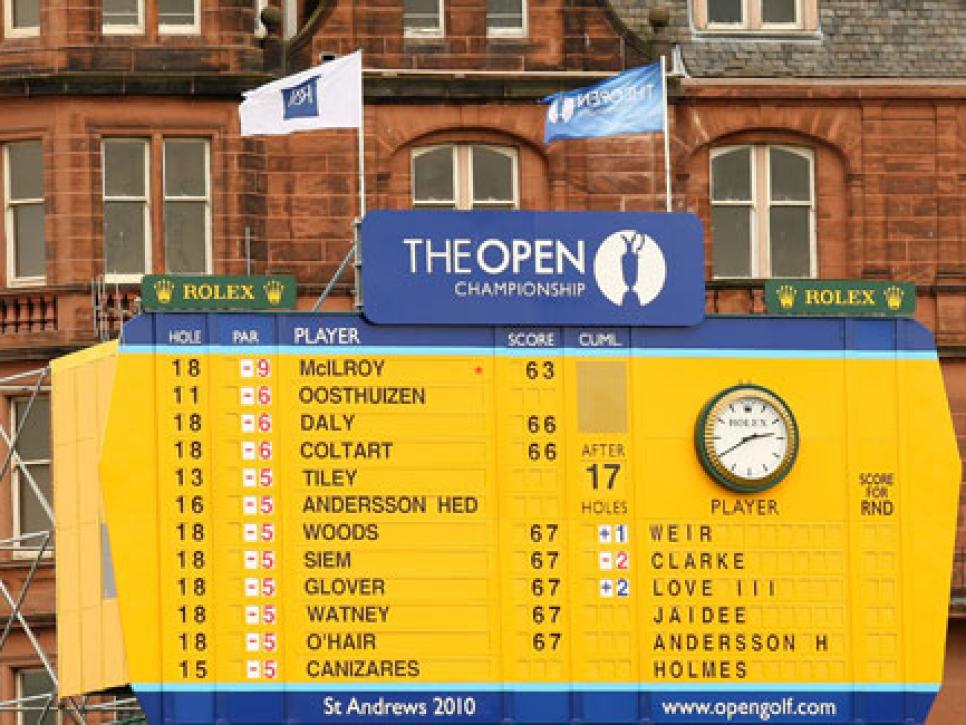News
Comes With The Territory

The Old Course yielded low scores during the morning, including Rory McIlroy's record-tying 63.
ST. ANDREWS, Scotland -- Already, I can hear the all-too familiar complaints from the usual collection of point-missers obsessed with the absurd notion that "proper" golf tournaments have to be won with scores closely adjacent to that entirely arbitrary number called par on the scorecard. "Too easy," they'll be whining. Or "sadly outdated in today's power game," they will pontificate. Or, heaven forbid, "just too short," they will sigh.
All of which is nothing the Old Course at St. Andrews hasn't been accused of before, of course. But the 63, the 65, the 66s and all those 67s recorded on the opening day of this 139th Open Championship are easy to explain -- and nothing to worry about. There is, after all, a single, simple reason why the old Scots phrase 'if there's nae wind, it's nae golf" has slipped inexorably into the dark world of clichedom: it's true, it has always has been true and, these days, it has never been more true.
Like all seaside links, the Old Course is left vulnerable when the breeze doesn't blow. And it is even more susceptible to low scoring the day after a near 24-hour deluge that all but eliminated any bounciness built up over the past month and a bit -- a period during which Caledonia (believe it or not) enjoyed a spell of warm, dry weather. Then there's the rough, or rather the general lack of it, at the Home of Golf. Unlike, say, your average U.S. Open venue, where the unimaginative combination of long grass, narrow fairways and brick-hard greens tends to keep the scores at or close to our old pal par, only on the penultimate hole does the Old Course take refuge in two of those three scourges of a modern game handcuffed by the silly distances leading golfers have been allowed to propel golf balls.
Put those three factors together and it's actually surprising that Rory McIlroy's nine-under-par effort -- remarkably, the 24th 63 in major championship history -- was the best of a day made up of a flat-calm morning and a mildly breezy afternoon. Abandoned by the game's rules makers and victimized by the weather Gods, golf's most famous venue was left with only one legitimate defense: fiendishly tucking the flags only a few measly yards over the still penal collection of bunkers.
Oh, all right, there's even more to all those low numbers than even all of the above. Whisper it, but minus the aforementioned wind, the Old Course just isn't that difficult for the really proficient practitioner. It never really has been, as two-time U.S. Open champion Curtis Strange's course record of 62 more than amply indicates. It is, in fact, made up of 17 holes ranging from incredibly easy to pretty straightforward, plus one incredibly tough par-4, the 495-yard Road Hole. And, even more to the point when we are talking about a gathering of the world's very best players, St. Andrews delivers a disproportionate advantage to those able to blast their hot balls beyond even the middle distance.
"St. Andrews really suits the long-hitters, just because of the places they can put the pins," said Scotsman Andrew Coltart, who shot a nifty little 66 in the company of John Daly. "John can attack some of those pins with his lob wedge and pitching wedge, but I can't with my 5-iron or whatever. Where he can fly his ball at the flag, I'm trying to run mine up; that's a lot harder to judge. So it sets up for guys like him."
That it does, a fact that the championship organizers, the Royal & Ancient Golf Club long ago recognized. Five years ago, the Open won by Tiger Woods was the first to be "played" on and/or stretched onto four courses at once: the Old, the New (9th tee), the Eden (12th tee) and the Himalayas putting course (2nd tee). This year, one can add the practice range (17th tee) to that particular rogue's gallery. Where it will end -- the first tee moved back onto the Scores embankment, leaving a breathtaking opening tee-shot over the clubhouse, or the 18th tee atop the Jigger Inn by the Old Course Hotel -- one can only imagine.